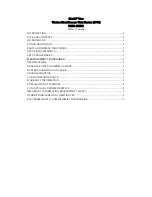
CMN-91
Installation and Operation Manual
Alarm Descriptions
© 2016 Imagine Communications Corp. Proprietary and Confidential.
Revision D | Page 132
Alarm Descriptions
The CMN-91 alarms monitor video and audio signals, time code errors, and GPI errors.
Limits are selected in the Setup menu by choosing a value using the curved arrow knob or the Up/Down
navigation buttons.
Sensitivity and Duration are two general terms used in the alarm menus.
Sensitivity is set by Consecutive Errored Samples (CES). When setting amplitude limits, a noise spike
can exceed the limit while the video amplitude can be within the limit. With the CES set to a low
number, a spike is detected and an alarm is displayed. Set the CES to a higher number to ignore the
fast spike. Each CES occurs at 37ns intervals for SD and 13.5ns for HD. Use this as a guideline to
select the appropriate CES value.
Not all alarms have CES associated with them; in such cases, use the duration to increase or
decrease the general sensitivity.
Duration is used to determine how long an error must persist before it is reported. Set the duration
to 0 to cause an error to be displayed as soon as the CES value is met.
Alarm Setup Menus
The Alarm Setup menu items, along with their corresponding Table and Description page locations are
listed below. An asterisk (*) is shown next to the default menu selections.
Video Alarms Setup Menu (on page
Audio Alarms Setup Menu (on page 137)
Time Code Alarms Setup Menu (on page 140)
GPI Alarms Setup Menu (on page 142)
See Navigating the Setup Menu (on page 103) for information on how to navigate through the Setup
menus.
Video Alarms Setup Menu
Menu Selections
Video Alarms Setup Menu
Selection
Selection Option
Selection Option
Selection Option
Format Change
Payload Identifier
Mismatch
















































